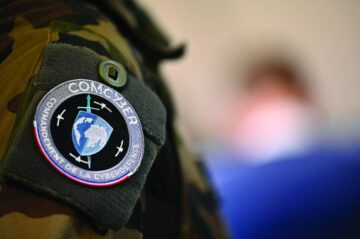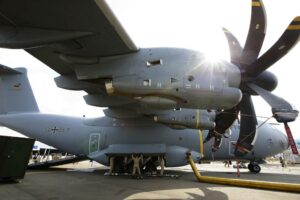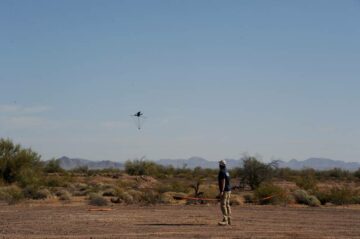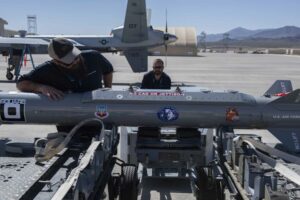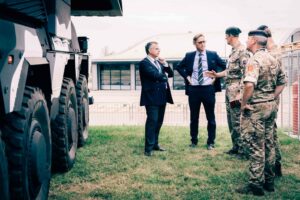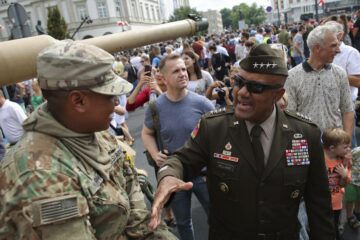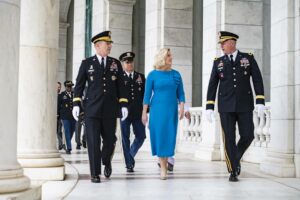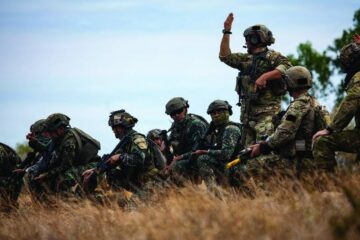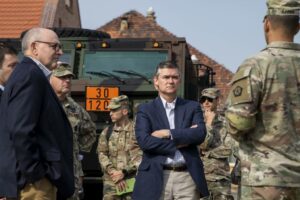
FORT LIBERTY, N.C. — Nearly a year into leading Army Futures Command, Gen. James Rainey says he’s no longer focused on modernizing the service; he wants to transform it.
The four-star command, based in Austin, Texas, opened five years ago to help the service modernize at an ambitious pace. It was originally meant to develop requirements and to work with the acquisition branch to produce nearly three dozen new weapons systems.
Now, Rainey said, he’s thinking beyond the equipment that troops will need to operate in a complex, highly contested space against high-end adversaries. Additionally, he plans to spend the next two years finalizing key decisions on the Army’s formational design in the 2040s.
Defense News sat down with Rainey on July 27 while he traveled to Fort Liberty, North Carolina, to address hundreds of soldiers at the Association of the U.S. Army’s Warfighter Summit. This interview was edited for length and clarity.
You are nearly one year in as the second general to serve as AFC’s commander. You’ve talked about the need to ensure Army formations will be ready to accept newly developed capabilities due in the 2030s. How are you approaching this?
I’m finding it useful to think about transformation and three distinct periods of time. I always tell people we only have one Army at a time. So [thinking about] 2030 and 2040, those are useful for planning and budgeting and thinking, but the main thing is, we only really have one Army. It’s the best army in the world right now, and AFC’s job is to make sure it’s the best army at any point in time in the future.
There’s deliberate modernization that everybody’s pretty well aware of. It’s going very well for a lot of reasons: Consistency — the Army hasn’t changed its modernization priorities for five years now. We’ve resisted moving the goal posts around and changing requirements. We’ve got good support, bipartisan support from Congress on our modernization efforts, and they’re starting to come to fruition.
If you go into the next decade, 2030-2040, we are working hard on the next Army Operating Concept based on the big evolutions, unprecedented disruption in terms of technology. There are some big changes to warfare, and figuring that out starts with [identifying] the future operating environment — not just our enemies, but demographics, climate, the economy, urbanization, what the future battlefield is going to look like, and how we need to operate to stay the best army in the world.
Then the third period of time that I’m starting to get more interested in is inside of two years — rapid acquisition, the speed of change. The amount of disruption and the character of warfare right now is unprecedented, so inside two years we need to do a better job of seeing something that’s happening on the battlefield, in technology, out in the Pacific, and turn that into no-kidding capability in a formation.
We can’t deliver something that doesn’t exist yet that fast, but the ability to look at a thing that actually exists, or a couple of things that exist, that if you integrate it, it would be a better thing. I refer to it as closing the acquisition kill chain. It starts with AFC. It’s my responsibility to write a clear requirement document, not for a specific piece of material but a requirement for a capability, and then work with [Army acquisition chief Doug] Bush’s acquisition guys, work with the contracting guys, work with industry to be able to get inside of two years. We should be able to see something happen and put it into the leading edge of our formations as no-kidding capability with the sustainment, with the leaders who know how to fight it, with soldiers who know how to use it and maintain it.
What’s the status of getting 24 systems into the hands of soldiers by the end of 2023? There was trouble with the Extended Range Cannon and concern it might get delayed.
Twenty-four in 2023 was about either putting them into formations or putting them into the hands of soldiers to learn. We’ve met all 24 systems we said we were going to put in the hands of soldiers.
But some of that was soldier touchpoints to learn and continue to refine the process. The requirement for extended-range fires is absolutely a valid requirement [based on] everything we’re seeing in Ukraine about the relevance of precision fires. The big killer on the battlefield is conventional artillery, high-explosive artillery, so that’s a really valid requirement whether it is the current manifestation of it, and how long that takes [to field]. But people get wrapped up in the current version; it’s really about the requirements.
Where are you in drafting the operating concept for beyond the 2030s? What’s expected in this first iteration?
It’s a little early, but we will have a 1.0 version of the concept. I would call it an emerging concept. We’ll have that out by the fall — how the Army’s going to fight as part of a joint force in the 2030-2040 time frame. What we found when we updated our current concept is that we published Multi-Domain Operations a year ago. It’s about a five-year process that becomes doctrine.
What’s next could be an evolution of [Multi-Domain Operations], could be something new. I won’t tell you the answers yet, but it’ll include what the competencies of the Army need to be. It’ll include a theory of victory. It’ll introduce new imperatives, things we need to be able to do that we can’t do now. It’ll introduce fundamental changes in the way we organize, train and fight, and really how we man.
You’ve said you want to field more, where appropriate, within a two-year time frame when technology is ready. What have you identified that might fit the bill?
Loitering munitions, and smaller, more agile, attritable [unmanned aerial vehicles]. We have some really good UAV programs, but we need to be watching what’s happening. We need to get into a [unmanned aircraft system] as a capability.
Ground-based rockets and ground-based missiles really focus in on our light infantry formations, increase in lethality and survivability, counter-UAS — we need more of it faster. There are commercial network capabilities, software and hardware on which we need to go faster.
What other adjustments have you made to the command, and why?
I did establish a forward headquarters inside the Pentagon with one of my deputies, [Willie Nelson, the deputy to the AFC commander], and a small team to improve our coordination and synchronization with Army staff, the Army secretariat, [the acquisition staff], the joint staff and the other services. And for better responsiveness to Congress, which is important. Then there’s industry and media.
But Austin is awesome. It’s exactly where I need to be. I have a lot of great partners down there, great support. There’s a lot of advantages to being outside the Capital Beltway. But it’s just a minor adjustment that I thought was important really based on my time having been the G-3/5/7 of the Army.
Army Futures Command has ownership over the Army Applications Laboratory and the Software Factory, which are both younger than the command. How are those fleshing out as tools to meet modernization goals? What else do you want to establish to fill in gaps?
There’s also the [Army Artificial Intelligence Integration Center] up at Carnegie Mellon [University]. Carnegie Mellon is where soldiers are going through the academically rigorous process of becoming data scientists. We indisputably know we’re going to need to be able to code and build applications, we know we’re going to need data scientists, so we got started building it while we’re figuring it out.
No decision from the Army yet [on the solution to a career field], and I personally believe there are new career fields that we don’t have yet. Our great Army warrant officers are where we look for the really deep technical expertise. There are some new warrant officer career fields. I’m not there yet on a new branch, but [rather] new functional areas for our officers. We’re still working on that, and the first cohort of the Software Factory will graduate in the December/January time frame. They’re going to move out to join actual units, so we’ll be putting the first cohort into the field.
The Army Applications Laboratory is about closing the acquisition kill chain; it’s about outreach to small business. It’s not the solution — it’s part of the solution.
One thing I’ve learned working with industry is they don’t waste money. They spend money where there’s a return on investment. Just like we need defense contractors, we need the integrator guys in the middle, we absolutely have to keep the smaller innovative companies, and they have to believe that there’s business opportunities working with the Army, working with the Department of Defense.
Is it inevitable the Army won’t deliver all of the 35 priority programs it set out to deliver by 2030?
We don’t plan to fail. If we didn’t think that we absolutely needed them, and if we didn’t think we could do it, we wouldn’t be doing them.
We have modernization efforts, we have enduring systems, we have good kit now. It’s going to be good kit, and we’re going to have it into the 2030s. And then we have legacy stuff that’s probably not part of the future. My belief is there are resources in place to modernize, and there are resources in place to sustain our enduring deployment. If we’re going to take risk in fiscal stuff, we will do it in the legacy fleet.
Jen Judson is an award-winning journalist covering land warfare for Defense News. She has also worked for Politico and Inside Defense. She holds a Master of Science degree in journalism from Boston University and a Bachelor of Arts degree from Kenyon College.
- SEO Powered Content & PR Distribution. Get Amplified Today.
- PlatoData.Network Vertical Generative Ai. Empower Yourself. Access Here.
- PlatoAiStream. Web3 Intelligence. Knowledge Amplified. Access Here.
- PlatoESG. Automotive / EVs, Carbon, CleanTech, Energy, Environment, Solar, Waste Management. Access Here.
- BlockOffsets. Modernizing Environmental Offset Ownership. Access Here.
- Source: https://www.defensenews.com/interviews/2023/08/08/seven-questions-with-gen-rainey-head-of-us-army-futures-command/
- :has
- :is
- :not
- :where
- $UP
- 1
- 10
- 2023
- 2030
- 24
- 27
- 3000
- 70
- 8
- 9
- a
- ability
- Able
- About
- absolutely
- Accept
- acquisition
- actual
- actually
- Additionally
- address
- Adjustment
- adjustments
- advantages
- against
- agile
- ago
- aircraft
- All
- also
- always
- ambitious
- amount
- an
- and
- answers
- any
- applications
- approaching
- appropriate
- ARE
- areas
- Army
- around
- artificial
- artificial intelligence
- Arts
- AS
- Association
- At
- austin
- award-winning
- aware
- based
- Battlefield
- BE
- becomes
- becoming
- been
- being
- belief
- believe
- BEST
- Better
- Beyond
- Big
- Bill
- bipartisan
- boston
- Boston University
- both
- Branch
- budgeting
- build
- Building
- business
- but
- by
- call
- capabilities
- capability
- capital
- Career
- Carnegie Mellon
- Carolina
- Center
- chain
- change
- changed
- Changes
- changing
- character
- chief
- clarity
- clear
- Climate
- closing
- code
- Cohort
- College
- come
- commercial
- Companies
- complex
- concept
- Concern
- conducts
- Congress
- continue
- contracting
- contractors
- conventional
- Convergence
- coordination
- could
- Couple
- covering
- Current
- data
- decade
- decision
- decisions
- deep
- Defense
- Degree
- Delayed
- deliver
- Demographics
- Department
- department of defense
- deployment
- deputy
- develop
- developed
- DID
- Disruption
- distinct
- do
- document
- Doesn’t
- doing
- Dont
- down
- dozen
- drone
- due
- Early
- economy
- Edge
- Edward
- efforts
- either
- else
- emerging
- end
- enduring
- enemies
- ensure
- Environment
- equipment
- establish
- Ether (ETH)
- everything
- evolution
- evolutions
- exactly
- exist
- exists
- expected
- expertise
- factory
- FAIL
- Fall
- FAST
- faster
- field
- Fields
- fight
- fill
- finding
- fires
- First
- Fiscal
- fit
- five
- FLEET
- Focus
- focused
- For
- Force
- formation
- Fort
- Forward
- found
- FRAME
- from
- fruition
- functional
- fundamental
- future
- future operating
- Futures
- gaps
- Gen
- General
- get
- getting
- Go
- goal
- Goals
- going
- good
- graduate
- great
- Ground
- Hands
- happen
- Happening
- Hardware
- Have
- having
- he
- head
- Headquarters
- help
- High-End
- highly
- holds
- How
- How To
- HTTPS
- Hundreds
- i
- identified
- identifying
- if
- image
- images
- important
- improve
- improvement
- in
- include
- Increase
- industry
- inevitable
- innovative
- inside
- integrate
- integration
- Intelligence
- interested
- Interview
- into
- introduce
- investment
- IT
- iteration
- ITS
- james
- Job
- join
- joint
- Joint Staff
- journalism
- journalist
- jpg
- July
- just
- Keep
- Key
- Kill
- kit
- Know
- laboratory
- Land
- Last
- Last Year
- latest
- leaders
- leading
- Leads
- LEARN
- learned
- Legacy
- Length
- Liberty
- light
- like
- little
- Long
- longer
- Look
- look like
- Lot
- made
- Main
- maintain
- maintenance
- make
- man
- master
- material
- meant
- Media
- Meet
- Mellon
- met
- Middle
- might
- minor
- missiles
- modernization
- modernize
- money
- more
- move
- moving
- my
- nearly
- Need
- needed
- network
- New
- newly
- news
- next
- no
- North
- north carolina
- now
- of
- Officer
- officers
- on
- ONE
- only
- operate
- operating
- Operations
- opportunities
- or
- originally
- Other
- our
- out
- outreach
- outside
- over
- ownership
- Pace
- Pacific
- part
- partners
- patrick
- pentagon
- People
- period
- periods
- Personally
- piece
- Place
- plan
- planning
- plans
- plato
- Plato Data Intelligence
- PlatoData
- Point
- Posts
- Precision
- pretty
- priority
- probably
- process
- produce
- Programs
- project
- published
- put
- Putting
- Questions
- range
- rapid
- rather
- ready
- really
- reasons
- refine
- relevance
- requirement
- Requirements
- Resources
- responsibility
- return
- right
- rigorous
- Risk
- s
- Said
- says
- Science
- scientists
- Second
- see
- seeing
- serve
- service
- Services
- set
- seven
- she
- should
- small
- small business
- smaller
- So
- Software
- solution
- some
- something
- Space
- specific
- speed
- spend
- Staff
- started
- Starting
- starts
- Status
- stay
- Still
- Summit
- support
- sure
- synchronization
- system
- Systems
- Take
- takes
- team
- Technical
- Technology
- tell
- terms
- texas
- than
- that
- The
- The Capital
- The Future
- the joint
- the world
- Them
- then
- theory
- There.
- they
- thing
- things
- think
- Thinking
- Third
- this
- those
- thought
- three
- Through
- time
- to
- tools
- Train
- Transform
- Transformation
- traveled
- trouble
- TURN
- two
- u.s.
- UAV
- Ukraine
- units
- university
- unprecedented
- updated
- us
- us army
- use
- Vehicles
- version
- very
- victory
- want
- wants
- Warrant
- was
- Waste
- watching
- Way..
- we
- Weapons
- WELL
- were
- What
- when
- whether
- which
- while
- WHO
- why
- will
- with
- within
- Work
- worked
- working
- world
- would
- Wrapped
- write
- year
- years
- yet
- you
- Younger
- zephyrnet

